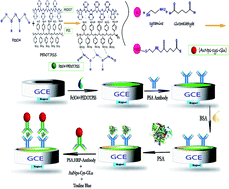An Fe3O4/PEDOT:PSS nanocomposite as an advanced electroconductive material for the biosensing of the prostate-specific antigen in unprocessed human plasma samples
Abstract
A novel sandwich-type biosensor based on a signal amplification strategy of various nanocomposites was developed to monitor the prostate-specific antigen (PSA) in real samples. The engineered immunosensor was fabricated using iron oxide magnetic nanoparticles modified with a polymer poly(3,4-ethylenedioxythiophene):poly(styrene sulfonate) [Fe3O4/PEDOT:PSS] conductive nanocomposite that utilized the immobilization of primary antibodies (biotinylated antibody (Ab1)). In order to improve the electron transfer rate, a cysteamine-capped gold nanoparticle (AuNPs-CysA) was applied for conjugation with a secondary antibody (HRP-Ab2). The fabrication procedure was investigated by square wave voltammetry. Under optimized experimental conditions, the calibration curve showed a wide linear range (0.001–0.5 μg L−1) for the PSA biomarker with a low limit of quantification of 0.001 μg L−1. Finally, satisfactory results were obtained for the determination of PSA in untreated human plasma samples, indicating the potential of the immunoassay for applications in clinical bioanalysis.



 Please wait while we load your content...
Please wait while we load your content...